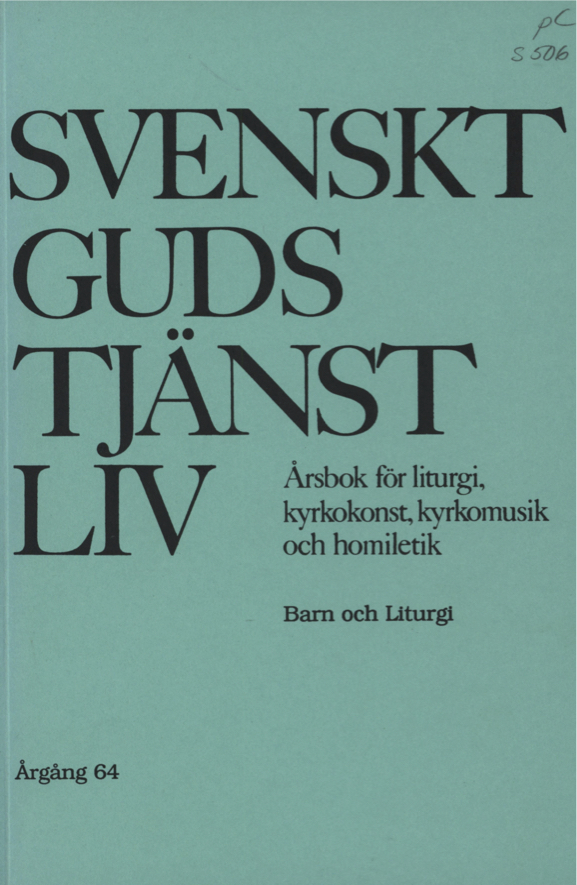Symboler och liturgiska riter i barns tänkande (Symbols and Liturgical Rites in the Thinking of Children)
Abstract
The liturgy can be seen as a kind of symbolic language, difficult to understand by way of reason, but open to a more original and deeper layer of consciousness within man. For the young children who do not have to wrestle with the limiting ability of reason, the symbols are accessible in a more immediate way and filled with emotional contents.
The symbolic function that enables man to orientate himself in life by the help of symbols, is being developed within the child as early as by the age of one year and a half. In comparison with the abstract words of the language, the symbols are concrete and to a certain extent personal. They are filled with feeling, imagination, and fantasy. During the early childhood the symbols and what is being symbolized are interwoven one with the other. This means that the child can ”read off’ the liturgical symbols as an allegoric picture writing where the invisible and intangible gain form and substance and a spiritual meaning.
Three development psychologists - Jean Piaget, Heinz Werner, and Maria Montessori - have each in his/her own way studied the symbolic thinking of children.
Piaget was the first one to open our eyes to the rare and magic world of childhood, filled with symbols and ritually formed. He documented the symbolic thinking of early child hood, i.e. the period when children have an intuitive understanding of the profundity of life and an emotional relationship to the reality surrounding them.
During school age, when logic presents itself, the symbolic world of entirety is torn into pieces. The thinking develops in a dualistic way, the symbols demand an intellectual analysis, and the ability to show immediate devotion, i. e. the basis for belief, turns out to be problematic. The children are now attracted to the exterior form of the symbols rather than their inner meaning. It is not until the time of adolescence that the symbols and the liturgical language gets back die same power over the senses as they have in the young child.
Heinz Werner was the one to draw parallels in his monumental crosscultural study between the thinking of children in our Western, highly developed culture and the thinking of adults in cultures with no written languages. In both types of culture he came across a sense of the universe which was characterized by symbols, rites, and magic. Both children and grown-ups in ”primitive” cultures sensed that they lived in a world governed by forces, where a person through prayer, invocations or sacrifices could make the existence (of God or gods) submit itself to the person’s own will. In the pre-logical thought which characterizes both children and primitive people, the dividing line between spirit and substance, subjectivity and objectivity, symbols and what is being symbolized, is lacking.
Maria Montessori is the woman who has been working directly with children and liturgy. In church schools started by her in Rome, the pupils were offered a teaching especially designed for them in the nuanced world of the Bible and in the liturgical rites. Music, singing, symbols, colors, silence - everything could be transformed into spiritual life. The children were taught by way of ingenious pedagogics and great dedication. Their senses were opened to the many symbolical and liturgical acts of the church and to spiritual life at large.
Unfortunately, today there are not many who have understood and taken care of the theories, thoughts and pedagogical efforts of the three researchers. Consequently, the pedagogics of religion have been problematic. People tend to fumble around here and there, try various more or less artificial tricks, and experience failures, hopelessness and confusion. The knowledge which is to be found in the theories of the three researchers could turn the course which the pedagogics of religion has taken and lead it back to a fruitful startingpoint.
(Transl: Gunborg Blomstrand)
Downloads
Publicerad
Nummer
Sektion
Licens
© författarna, Laurentius Petri Sällskapet för svenskt gudstjänstliv samt Artos & Norma bokförlag. Det är tillåtet att kopiera och använda material ur Svenskt Gudstjänstliv för forskningsändamål om källan anges. För övriga ändamål kontakta respektive artikelförfattare samt förlaget. Särskilda restriktioner kan gälla för bildmaterial.


